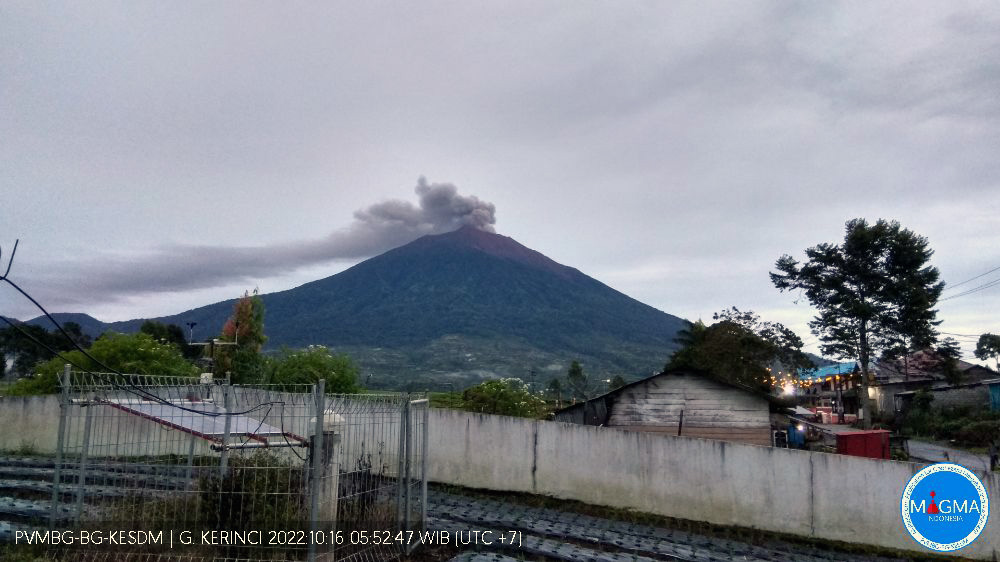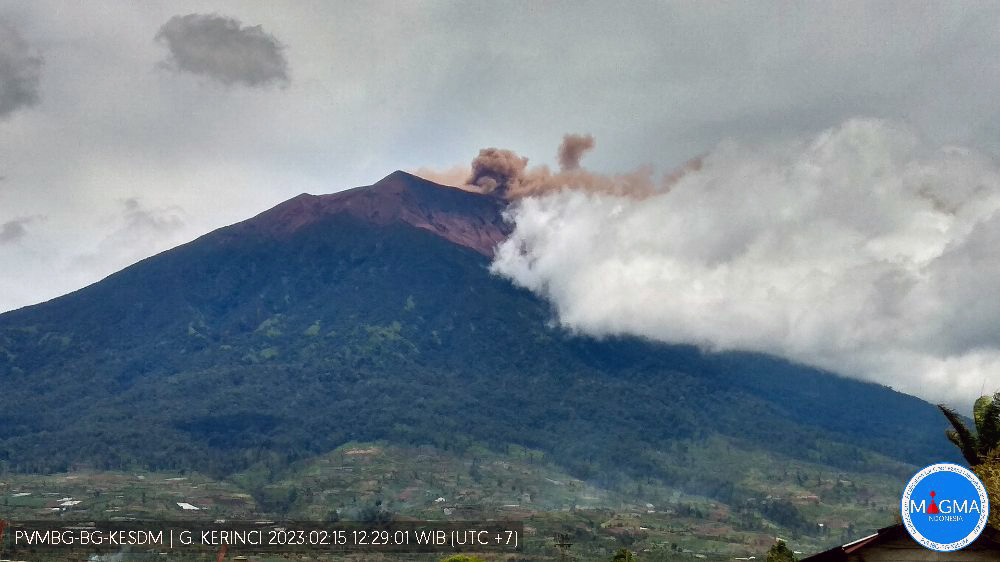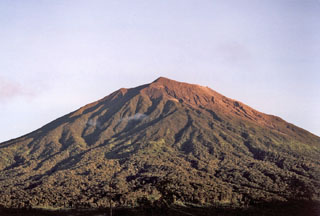Report on Kerinci (Indonesia) — March 2023
Bulletin of the Global Volcanism Network, vol. 48, no. 3 (March 2023)
Managing Editor: Edward Venzke.
Research and preparation by Paul Berger.
Kerinci (Indonesia) Eruption during October 2022-February 2023 with minor ash plumes
Please cite this report as:
Global Volcanism Program, 2023. Report on Kerinci (Indonesia) (Venzke, E., ed.). Bulletin of the Global Volcanism Network, 48:3. Smithsonian Institution.
Kerinci
Indonesia
1.697°S, 101.264°E; summit elev. 3800 m
All times are local (unless otherwise noted)
Kerinci, a stratovolcano in central Sumatra, Indonesia, has had numerous moderate explosive eruptions since 1838. The previous eruption lasted from April 2018 until June 2021 and included intermittent gas-and-steam and ash plumes (BGVN 43:07, 46:07). This report covers activity during July 2021-February 2023, and is based on data from the Pusat Vulkanologi dan Mitigasi Bencana Geologi (PVMBG), also known as the Center for Volcanology and Geological Hazard Mitigation (CVGHM), the Darwin Volcanic Ash Advisory Centre (VAAC), and satellites.
A new eruption began on 15 October 2022, when observers reported plumes with brown, gray, or black ash that drifted downwind a short distance above the crater, with the highest rising 1.2 km on 12 January 2023; the last reported ash plume was on 27 February 2023. Weather clouds obscured the volcano on most days, allowing only infrequent good webcam photos or satellite images. Although ash plumes were often seen, white steam-and-gas plumes were also visible on many days. There were no thermal anomalies detected over the course of this activity in Sentinel-2 or MODIS data. Though infrequently observed by the TROPOMI instrument aboard the Sentinel-5P satellite, the sulfur dioxide plumes that were detected were localized above the volcano.
According to PVMBG’s MAGMA-Indonesia daily reports from July 2021 through early October 2022, no explosions or ash emissions were observed; white emissions were observed most days when weather permitted. The Darwin VAAC issued an advisory for a plume on 14 October 2021 that reached as high as 750 m, but no ash was identified in satellite data and PVMBG only observed a white steam-and-gas plume. During 15-16 October a new eruption began with a steam-and-ash plumes that rose about 50-350 m above the summit (figure 25) and drifted NE. According to PVMBG and the Darwin VAAC, on 19 October, at 0620 and 0815, ash plumes rose 500-700 m above the summit. On most subsequent days in October ash emissions were visible rising 300-750 m above the summit and drifting primarily NE and NW.
 |
Figure 25. Webcam photo of Kerinci on 16 October 2022 showing a gray ash plume rising from the summit crater. Courtesy of MAGMA Indonesia. |
In November, ash plumes rose 150-400 m and drifted in various directions. At 0830 on 27 November an ash plume rose 400 m and drifted E. During 29-30 November, white steam-and-gas plumes rose 300 m. During December, frequent ash plumes and white steam-and-gas plumes rose 100-300 m almost daily, except for an ash plume at 0822 on 6 December which rose 700 m and drifted SW. According to PVMBG, the amplitude of continuous tremor increased during 28-29 December.
The eruption was ongoing during 4-8 January with brown, brown-to-gray, or white-and-brown ash plumes rising as high as 200 m above the crater rim and drifting NE and E. During 10-14 January daily ash plumes that were brown or gray rose generally 400-900 m above the summit and drifted N, NE, and W. At 1810 on 12 January a dense gray ash plume rose 1.2 km above the summit and drifted NW.
An eruptive event was recorded at 0230 on 3 February but not visually confirmed; white-and-gray ash plumes were visible later that day rising 100 m above the summit and drifting NE and E. Plumes with brown or gray ash were visible when conditions were clear, typically in the early morning hours, during 4-10 and 14 February, with small plumes only reaching 150-200 m above the summit and drifting in easterly directions. At 1207 on 15 February a dense brown ash plume rose 200 m and drifted E (figure 26). Dense brown ash plumes rose 150-250 m and drifted E and SE at 0908 and 1937 on 16 February. Plumes with gray or brown ash rose 50-150 m above the crater rim on 26 and 27 February.
 |
Figure 26. Webcam photo of Kerinci showing a brown ash plume rising from the summit crater on 15 February 2023. Courtesy of MAGMA Indonesia. |
Geological Summary. Gunung Kerinci in central Sumatra forms Indonesia's highest volcano and is one of the most active in Sumatra. It is capped by an unvegetated young summit cone that was constructed NE of an older crater remnant. There is a deep 600-m-wide summit crater often partially filled by a small crater lake that lies on the NE crater floor, opposite the SW-rim summit. The massive 13 x 25 km wide volcano towers 2400-3300 m above surrounding plains and is elongated in a N-S direction. Frequently active, Kerinci has been the source of numerous moderate explosive eruptions since its first recorded eruption in 1838.
Information Contacts: Pusat Vulkanologi dan Mitigasi Bencana Geologi (PVMBG, also known as Indonesian Center for Volcanology and Geological Hazard Mitigation, CVGHM), Jalan Diponegoro 57, Bandung 40122, Indonesia (URL: http://www.vsi.esdm.go.id/); MAGMA Indonesia, Kementerian Energi dan Sumber Daya Mineral (URL: https://magma.esdm.go.id/v1); Darwin Volcanic Ash Advisory Centre (VAAC), Bureau of Meteorology, Northern Territory Regional Office, PO Box 40050, Casuarina, NT 0811, Australia (URL: http://www.bom.gov.au/info/vaac/); Global Sulfur Dioxide Monitoring Page, Atmospheric Chemistry and Dynamics Laboratory, NASA Goddard Space Flight Center (NASA/GSFC), 8800 Greenbelt Road, Goddard, Maryland, USA (URL: https://so2.gsfc.nasa.gov/); Sentinel Hub Playground (URL: https://www.sentinel-hub.com/explore/sentinel-playground); MIROVA (Middle InfraRed Observation of Volcanic Activity), a collaborative project between the Universities of Turin and Florence (Italy) supported by the Centre for Volcanic Risk of the Italian Civil Protection Department (URL: http://www.mirovaweb.it/).

